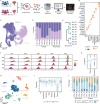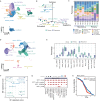Single-cell dissection of multifocal bladder cancer reveals malignant and immune cells variation between primary and recurrent tumor lesions
- PMID: 39702554
- PMCID: PMC11659313
- DOI: 10.1038/s42003-024-07343-7
Single-cell dissection of multifocal bladder cancer reveals malignant and immune cells variation between primary and recurrent tumor lesions
Abstract
Bladder carcinoma (BLCA) is characterized by a high rate of post-surgery recurrence and multifocality. Multifocal tumors have a higher risk of recurrence compared to single tumors, significantly impacting bladder cancer-specific mortality. However, the interregional or intraregional heterogeneity within both primary and recurrent tumors remains poorly understood. Here, we employed single-cell RNA sequencing to analyze tumor lesions from five multifocal bladder cancer patients comprising three primary tumors and two recurrent tumors. Our findings revealed that malignant cells derived from recurrent multifocal bladder cancer exhibited higher interregional transcriptional similarity and consistent cellular communication. Furthermore, our analysis uncovered that malignant cells from recurrent tumors may evade immune destruction by suppressing cytokine responses and natural killer cell activity. Notably, we identified a preference for the expression of the tryptophan metabolic enzyme IL4I1 on SPP1+ macrophages in recurrent tumors. Functional analyses have revealed that IL4I1 may promotes tumor progression in recurrent tumors by activating the aryl hydrocarbon receptor (AHR) and recruiting regulatory T cells to suppress adaptive immunity. Taken together, our study provides a comprehensive understanding of primary and recurrent multifocal bladder tumors, offering valuable resources for analyzing the multifocality and recurrence of bladder cancer.
© 2024. The Author(s).
Conflict of interest statement
Competing interests: The authors declare no competing interests. Ethics approval and consent to participate: Informed consent was obtained for all patients and the study was approved by Shanghai Tenth People’s Hospital (22KN209).
Figures






References
MeSH terms
LinkOut - more resources
Full Text Sources
Medical
Molecular Biology Databases
Research Materials
Miscellaneous

